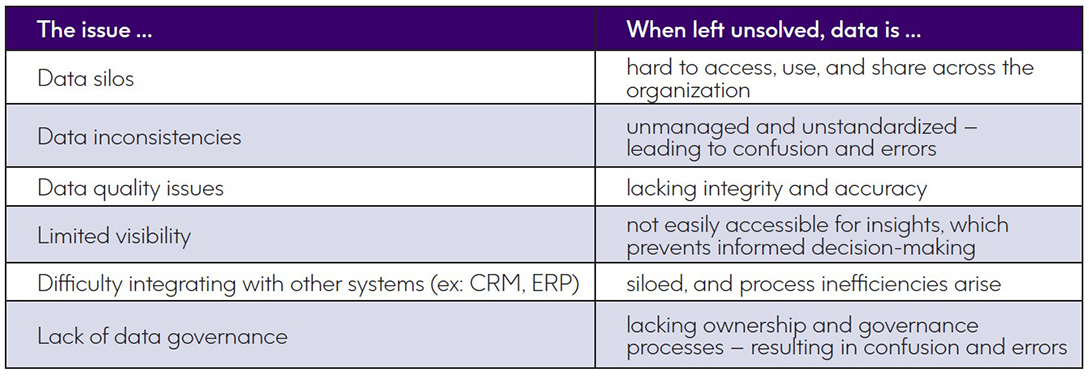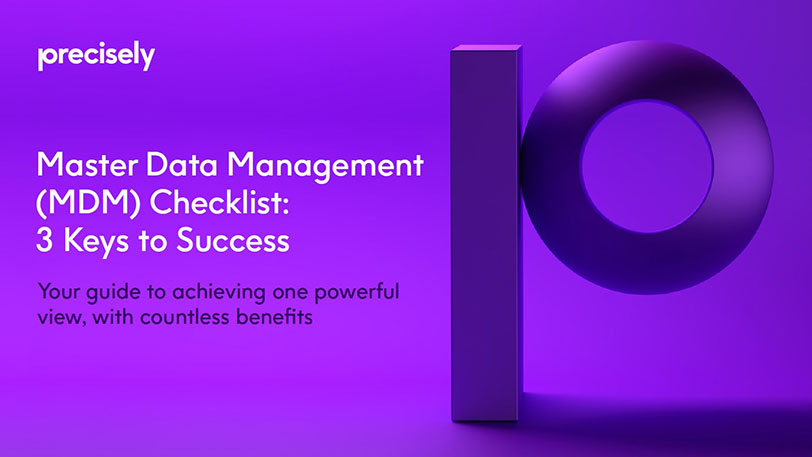eBook
Master Data Management (MDM) Checklist: 3 Keys to Success
Introduction
It’s an all-too-common scenario: critical data continues to flow into your organization through a growing list of business applications: mergers and acquisitions, new product launches, digital transformation initiatives, and so on. And when that data is siloed across your various data domains, you’re held back from maximizing its value. Not to mention, vendors and suppliers all have their own array of applications and data systems, which complicates the issue further.
Why does this matter?
Data silos have dangerous downstream impacts for your business – they create duplicates of critical data and generate false insights that lead to ineffective and costly decisions.
It’s also important to be aware of other common issues that we see for organizations as they accumulate more data – from more sources – than ever before. Here’s a glimpse:

Any (or all) of these challenges sound familiar? Not only do they lead to countless headaches for everyday users, but the effects can be very damaging for the business at large, leading to
- difficulty trusting the data for informed and timely decision-making – or, making incorrect and costly decisions with that data
- loss of opportunity due to an inability to leverage data insights
- higher operational costs to manually manage master data


of CEOs say they’re concerned about the integrity of the data they’re making decisions on.
(Forbes)

of orgs say siloed data negatively impacts their org
(Data Trends Survey 2019)

of all newly created data records have at least one critical error
(HBR)
What’s the solution?
Master data management (MDM): providing you with one powerful holistic view across all your critical data domains.
In other words: fewer headaches and more of the results you need. Here’s just a snapshot of what a multi-domain MDM can do:
- Manage high-quality golden records of master data, and other critical business information in a single, centralized hub
- Ingest any type of data from any source, validate, consolidate, transform, standardize, and syndicate that data to any target, internal, or external
- Analyze data in the context of other domains and data types to gain cross-domain intelligence for better decision-making
That means more agile and confident decision-making, higher ROI, stronger compliance, and more.
Let’s explore how to ensure success around management of your master data.


3 keys to success in master data management
The right MDM solution needs to check multiple boxes – and it’s never solely about the product itself.
Here, we’ll cover what you need to ensure success in your master data management initiative – helping you gain that single, “golden record” of your strategic data assets for fast, accurate decision-making.
We break it down into three components, with a checklist of items to keep in mind for each:
1. Technology
2. Processes
3. People
Technology
Getting trusted data and content to the systems and channels that power your business – at the speed the market demands, at scale, and from a single platform – requires core multi-domain MDM capabilities.
The following list describes necessary requirements for an MDM solution that drives incremental revenue, reduces costs, and transforms your digital initiatives into a competitive advantage.
- Flexibility and scalability to adapt and grow with your organization
– Right-size your MDM solution – adding capabilities and other domains once you’re ready. In other words: start small, think big, scale fast. Best in class MDM solutions will enable growing companies to add unlimited domains as they expand. - Powerful capabilities to ingest, match, and merge critical data to create a single golden record
– Create a trusted golden record by aggregating data from legacy and modern sources – and maintain a record of how the record was matched and merged. - Robust data quality, standardization, and tracking to continuously improve master data
– Profile your data, and identify and rectify gaps in quality at every step of the data’s lifecycle. Versioning, audit, and rollback capabilities are imperative to track who made the change, when it was made, compare multiple versions, and rollback to a given version when needed. - Process automation to get trusted data where it needs to go – faster
– Syndicate and synchronize master data to internal and external partners to drive immediate value. Workflows, escalation emails, and visibility into process status are needed to track accountability and deliver timely data insights and improvements. - Cross-domain intelligence to empower teams with more timely and accurate decisions
– Make sense of your data, and create linked relationships between different data domains within the solution to surface valuable insights from other sources
Processes
We’ve found that regardless of your organization’s size, industry, or go-tomarket strategy, successful data programs all share four key components that complement your tech investments:
- Data governance framework to clearly align data to your objectives
– This also includes an opportunity to increase data literacy enterprisewide. Even terms that seem straightforward (like “customer,” “vendor,” etc.) can be misinterpreted and improperly applied across different business functions – a common pitfall that can be easily avoided. - Metrics framework to measure and demonstrate value
– How is the level of data quality tied to performance metrics in a meaningful way? Making these links are crucial – otherwise, data quality metrics are meaningless to the business. - Data harmonization framework to eliminate opinions and focus on the facts
– It’s important here to first determine the criteria that makes data important to stakeholders, and then identify the data that’s the best fit to drive the most organizational value. Data harmonization prioritizes the data within your business to identify high-value returns on your MDM investment. - Operating model that documents business accountability
– Aligning the right roles and individuals for the tasks, and adapting as the business evolves, is dependent on a model that engages strategic, operational, and tactical teams.

Technology, processes, and people all need to be in sync to ensure a successful MDM transformation. They all work together to help you break down data silos, improve data quality and governance, and fuel better insights that power more lucrative decisions.
People
Data involves a lot of people throughout the organization. Many key roles may not even consider data as part of their role, even when that’s not the case.
Here are some things to keep in mind:
- Clearly align teams around the goals of the program
- Outline their specific roles in the process
- Empower teams by pointing out the capabilities and results that matter most to them
Let’s dive a bit deeper into that last point with a few examples for the front and back-office teams.
Business teams can drive incremental revenue with the ability to:
- Quickly test and scale new business models and channels
- Create tailored offers and content
- Make better decisions
- Use enriched, accurate data across domains
Data and IT teams can drive better business results with the ability to:
- Syndicate and synchronize trusted data across systems
- Meet data quality and compliance goals
- Configure, not code to keep pace with your dynamic business
- Get granular control over who can modify data models and business rules
Ready to get started? Meet a solution that checks all the boxes: Precisely EnterWorks
EnterWorks is an enterprise-grade multi-domain MDM data hub that enables you to compete and thrive in today’s digital economy – across all your channels.
Integrate enterprise databases and applications to create a “golden record” for your strategic data assets across your systems to enable better decision making – at the speed the market demands, at scale, and all from a single solution. Leveling up traditional master data management, it provides you with the tools you need to drive incremental revenue, reduce costs, and transform your digital initiatives into a competitive advantage.
All of this, with a no-code, low-code design that empowers business and data teams to accelerate processes and create a golden record across multiple domains – including product information management (PIM),product, customer, vendor, material, location, and more – without sacrificing functionality.
